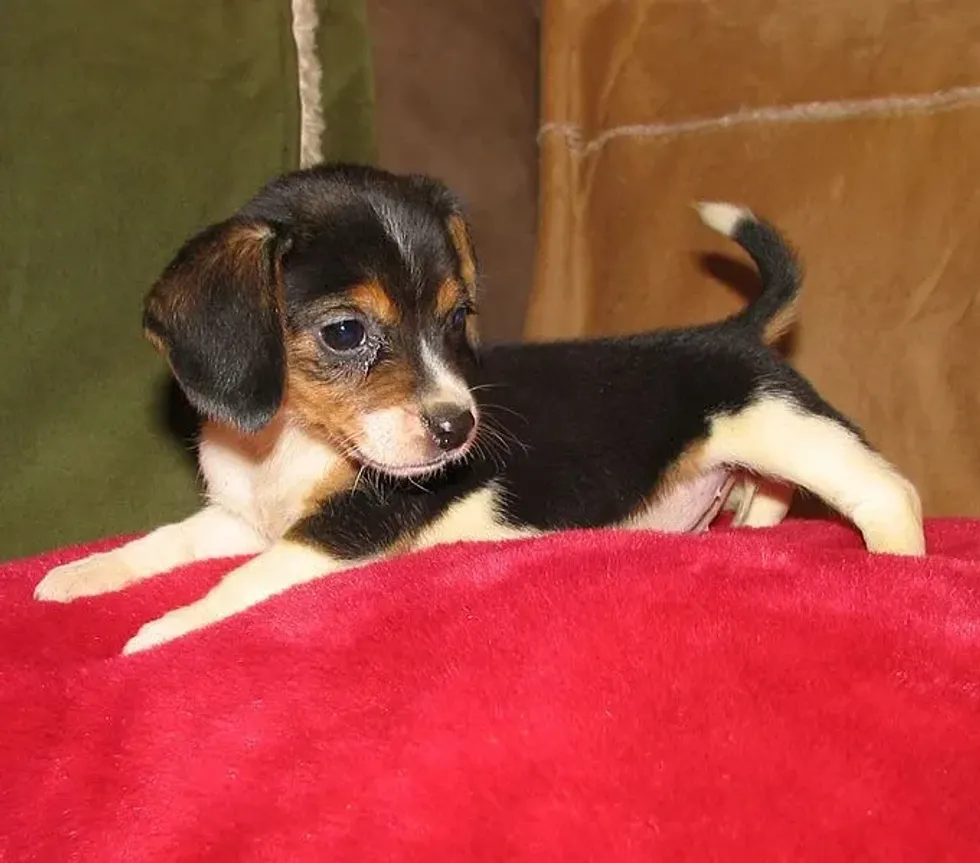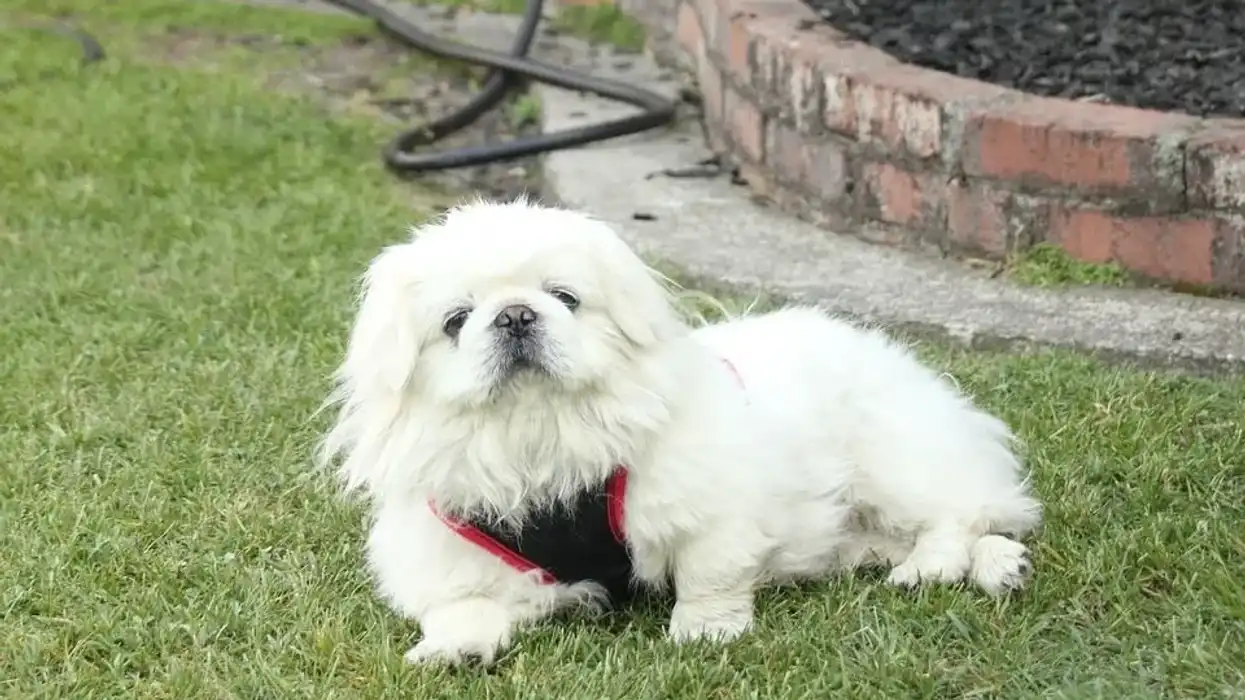Fun Pocket Beagle Facts For Kids

Did you ever want a dog so small that it would fit in the pocket of your coat? A dog that is so easy to carry and take to different places?
Well, you would be happy to know that such a dog exists. A pocket beagle is just the size of your pocket.
Its sibling, the beagle, is one of the most famous dogs globally and ranked number 6 in all dog species across the United States. Few people know that a more compact and adorable species of this dog, known as the pocket beagle, exists. They measure 2-3 in (5-12 cm) smaller than a typical beagle.
These dogs are curious, intelligent, and fun-loving tiny scent hounds. The pocket beagle breed has been recognized by the American Kennel Club.
They first became famous when Queen Elizabeth used to carry them in her saddle pocket. These dogs were renamed Queen Elizabeth pocket beagles.
Queen Elizabeth used to call these the singing dogs, and she would leave them on the table to entertain her guests. Although they are not recognized by AKC as an independent dog type, they are registered as smaller standard beagles. Like other designer dog breeds, pocket beagles are very expensive dogs.
After reading these interesting facts on pocket beagle dog breed, do check out our other articles on miki dog and Kunming wolfdog as well.
Pocket Beagle Interesting Facts
What type of animal is a pocket beagle?
Pocket beagle dog breeds are essentially miniature beagles that are half the weight and size of a standard beagle dog. They might look vulnerable from their appearance, but they are hunting dogs. Queen Elizabeth was the reason why they became famous.
English pocket beagles are hunting hounds that measure only 9 in (22 cm) tall at the shoulder. Miniature beagles are more susceptible to health problems because they are small and vulnerable.
On the other hand, the pocket beagle temperament is rough, tumble, and ready for action. They are small on purpose, designed for hunting and tracking. These breeds have large floppy ears that cover their faces making them look adorable.
What class of animal does a pocket beagle belong to?
A pocket beagle belongs to the class of mammals. Miniature beagles are scent hounds that will follow any attractive scent in the air.
Miniature beagle dogs are half of the usual beagle size, but they are stronger than typical beagles. Miniature beagles are also referred to as mini beagle, Olde English pocket beagle, teacup beagle, miniature beagle, and several other terms. They are tri-colored dogs, with large black areas and light brown shading.
Mini beagle dogs are available in a variety of shades, from classic tri to a jet black beagle. Pocket beagles are bred to hunt small animals like rabbits and large hares.
How many pocket beagles are there in the world?
There are more than 65,000 pocket beagles around the world. Their population increased after they became popular as Queen Elizabeth's pocket beagles.
Where does a pocket beagle live?
Pocket beagles are purebred dogs, and they are found in the care of shelter groups, rescue groups or in loving homes with families. Small beagles prefer to live with families and hate to be left alone in the house. If you leave them alone for too long, they can turn disruptive and destroy things.
What is a pocket beagle's habitat?
Full grown pocket beagles are company-loving animals, so you can find them in houses, shelter homes, or rescue homes. Beagles enjoy human contact and love playing with their two-legged pals.
You have to make them exercise daily so that they don't fall ill. It's extremely dangerous to leave your beagle locked in your home, as they don't like staying alone and can turn mischievous if left alone.
Who do pocket beagles live with?
Pocket beagles love staying with their two-legged friends and they enjoy playing with them. Full grown pocket beagles also play with other pets and children. Company is what they crave the most. They are extremely loving and friendly in nature. These adorable little pets like to stay close to their pals.
How long does a pocket beagle live?
A healthy pocket beagle can live up to between 12 and 15 years of age. But like most other small dog varieties, they are prone to health problems, and they are often afflicted with various medical ailments.
Most of these adorable little pets suffer from these ailments because of poor breeding practices. Among the various disease that affect pocket beagles, a few are hip dysplasia, patella luxation, intervertebral disc disease and dwarfism. Nutritious dog food and regular exercise are essential for their good health and longevity.
How do they reproduce?
Pocket beagle adults usually start their breeding cycle at the age of two. They experience strong waves of heat during their breeding cycle.
They have two heat cycles in a year, and they reproduce during these cycles. It is necessary to allow the beagle to rest between these cycles, or they will experience illnesses.
These breeds usually stop breeding at the ages of five to seven years, but it depends on the evaluation by a veterinarian. Some even retire earlier. Your dog will not start breeding immediately after they come in heat.
They may take two weeks, but some take even longer. The gestation period of a pocket beagle is between 60 and 65 days, after which a litter of pocket beagle puppies is born.
What is their conservation status?
The original authentic pocket beagle species is long Extinct. However, the pocket beagle species available now are essentially small dogs of the beagle breed. Their numbers are steadily growing and the modern pocket beagles do not face any existential threats.
Pocket Beagle Fun Facts
What do pocket beagles look like?
Mini beagle dogs are small sized dogs whose size is below 13 in (33 cm). Pocket beagle breeds appear as muscular yet lean dogs with deep chests, long tails, and defined features. Their coat is soft to touch yet dense.
Ears of this species are floppy and cover their faces. Nine different fur colors are exhibited by this breed.
This variety in the color of the coat means not all beagles are black and tan. Occasionally you can get an albino pocket beagle, but they are extremely rare. Among the various colors they are mostly white, brown, red, black, bluetick, lemon, tricolor, pied, and tan.

How cute are they?
Pocket beagles are irresistible. These small dogs make for excellent companions and have a mild temperament. They happily snuggle with their family members and are good with older as well as younger humans.
How do they communicate?
Pocket beagles are known to be very vocal dogs. Pocket beagle breeds will never hesitate to listen when spoken to. They may also be very vocal when they are bothered. However, these dogs bark, howl and yap a lot. They may also whine and whimper if they want to get your attention.
How big is a pocket beagle?
Typically, pocket beagle sizes range between 8-13 in (20-33 cm), defined by beagle breed standard. Beagles are so small that they can fit in the pockets of a human.
How fast can a pocket beagle run?
An adult beagle can run as fast as 15 mph (24 kmph) over short bursts. Pocket beagle breed dogs make a very good partner for running, and your pocket beagle can make your jogs feel like an adventure trip. Moreover, beagles are high-energy breeds that require regular exercises to be fit and healthy.
How much does a pocket beagle weigh?
A pocket beagle is very light. They weigh 15-18 lb (6.8-8.1 kg). Because their height and weight fall below the standard dog size, it is not recognized by the American Kennel Club as being a totally different species. They have a height of 13 in (33 cm).
What are the male and female names of the species?
Beagles have no separate name for a male and female beagle. Miniature male beagles are known as a dog and a miniature female beagles are called a bitch.
What would you call a baby pocket beagle?
Babies of the teacup beagle is called a pocket beagle puppy. A pocket beagle puppy may also be referred to as a miniature beagle puppy.
What do they eat?
Pocket beagles are omnivorous animals. This dog breed eats everything ranging from meat to vegetables. They need a variety of nutrients to stay fit and healthy. Dog food containing protein, natural fats, and carbohydrates is most suitable for their health.
Are they hypoallergenic?
Pocket beagles are not hypoallergenic as they shed all year long, with even more hair falling during the spring season. The heavy shedding season means that your pooch is preparing for a brand new winter coat.
Like bigger beagles, miniature beagles have drop years that are prone to infections. Regular grooming with help of a bristle brush is extremely important.
Would they make a good pet?
Yes, as pocket beagles love staying in the company of their human counterparts, they make excellent pets. They are popularly known for craving attention, and they may whimper and whine in front of you.
Pocket beagles like playing and they make every member of their family play along. You can't ignore the adorable beagle face. Regular exercise is required to manage their weight and other health problems.
Did you know...
Pocket beagles tail end is always white. This made it easy for the hunters to spot their dogs in the forest while hunting.
These hunters used to carry these pocket beagles in their pocket and go hunting. This species is one of the most intelligent dog species. Dogs of this popular breed may get mischievous when they are bored.
Beagles throw their head back and howl as loud as they possibly can. If you don't train them to do otherwise, they will howl continuously, and it can become irritating.
Pocket beagles also tend to dig when they get bored, so it is advised not to let them get bored. Challenge them with a new toy. The cost of a pocket beagle puppy can vary slightly across regions.
Pocket beagle puppy prices start from 400 USD and extend up to 1,000 USD. You can get this popular breed from pocket beagle rescues at a much lower price of around 100 to 200 USD.
What's the difference between a beagle and a pocket beagle?
Old English pocket beagles are half the size of a regular beagle. Their height ranges from 7-12 in (17-30 cm) and cannot exceed 13 in (33 cm). An adult fully grown pocket beagle weighs about 15-18 lb (6.8-8.1 kg), whereas the beagle weighs about 22-30 lb (9.9-13 kg).
Are pocket beagles good dogs?
Pocket beagles are good family dogs who only know how to love. They are gentle dogs and play with your children all day long.
These dogs are loyal to your children and will follow them everywhere. They will also play with your other pets. The reason for their politeness is that their ancestors were actually well-built and guard dogs who used to serve and protect the people around them.
This is why they possess such a good temperament and like to be around people. Regular training and exercise are important to optimize their weight and mold their behavior.
Here at Kidadl, we have carefully created lots of interesting family-friendly animal facts for everyone to discover! Learn more about some other mammals including corgi beagle mix, or dachshund beagle mix.
You can even occupy yourself at home by drawing one of our beagle coloring pages.
We Want Your Photos!
More for You
See All
Bachelor of Science specializing in Human Anatomy

Joan AgieBachelor of Science specializing in Human Anatomy
With 3+ years of research and content writing experience across several niches, especially on education, technology, and business topics. Joan holds a Bachelor’s degree in Human Anatomy from the Federal University of Technology, Akure, Nigeria, and has worked as a researcher and writer for organizations across Nigeria, the US, the UK, and Germany. Joan enjoys meditation, watching movies, and learning new languages in her free time.
Bachelor of Science specializing in Computer Science

Chandan ShuklaBachelor of Science specializing in Computer Science
With a Bachelor's degree in Computer Science from Aryabhatta College, University of Delhi, Chandan is a skilled and passionate technophile. He has completed a machine learning training program and is adept in various programming languages. He has been working as a content writer for two years while also striving to become a proficient tech professional.
Disclaimer
1) Kidadl is independent and to make our service free to you the reader we are supported by advertising. We hope you love our recommendations for products and services! What we suggest is selected independently by the Kidadl team. If you purchase using the Buy Now button we may earn a small commission. This does not influence our choices. Prices are correct and items are available at the time the article was published but we cannot guarantee that on the time of reading. Please note that Kidadl is a participant in the Amazon Services LLC Associates Program, an affiliate advertising program designed to provide a means for sites to earn advertising fees by advertising and linking to Amazon. We also link to other websites, but are not responsible for their content.
2) At Kidadl, we strive to recommend the very best activities and events. We will always aim to give you accurate information at the date of publication - however, information does change, so it’s important you do your own research, double-check and make the decision that is right for your family. We recognise that not all activities and ideas are appropriate for all children and families or in all circumstances. Our recommended activities are based on age but these are a guide. We recommend that these ideas are used as inspiration, that ideas are undertaken with appropriate adult supervision, and that each adult uses their own discretion and knowledge of their children to consider the safety and suitability. Kidadl cannot accept liability for the execution of these ideas, and parental supervision is advised at all times, as safety is paramount. Anyone using the information provided by Kidadl does so at their own risk and we can not accept liability if things go wrong.
3) Because we are an educational resource, we have quotes and facts about a range of historical and modern figures. We do not endorse the actions of or rhetoric of all the people included in these collections, but we think they are important for growing minds to learn about under the guidance of parents or guardians.







